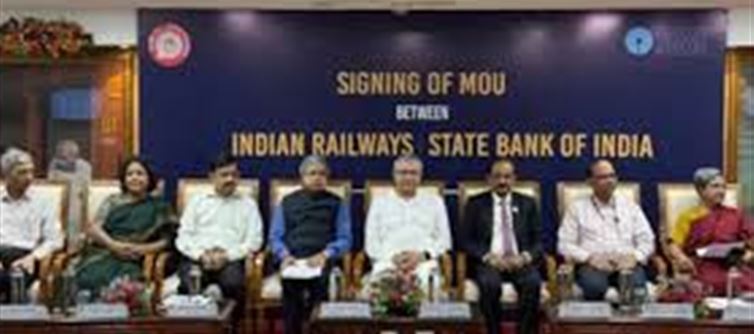
In a landmark step towards employee welfare, the State bank of india (SBI) and the Indian Railways signed a historic Memorandum of Understanding (MoU) on monday at Rail Bhavan, New Delhi. The agreement was signed in the presence of Railway minister Ashwini Vaishnav, Railway Board Chairman Satish Kumar, and SBI Chairman CS Setty, marking a major boost in social security benefits for lakhs of railway employees.
What the Agreement Means
This collaboration between the country’s largest bank and one of its biggest employers is focused on financial protection and employee security.
- All railway employees with salary accounts in SBI will now be entitled to enhanced insurance benefits.
- The benefits will be provided at no extra cost—employees will not have to pay any premium or undergo medical tests.
- The enhanced coverage will be linked to RuPay debit cards issued with salary accounts.
The Biggest Benefit: ₹1 Crore accident Insurance
Until now, the insurance coverage available under the Central Government Employees Group Insurance Scheme (CGEGIS) was relatively modest:
- Group A employees: ₹1.20 lakh
- Group B employees: ₹60,000
- Group C employees: ₹30,000
Under the new SBI–Railways agreement:
- Employees will get accident insurance cover up to ₹1 crore.
- For natural death, an insurance cover of ₹10 lakh will be provided.
- For permanent total disability in an accident, the cover will be ₹1 crore.
- For permanent partial disability, the cover will be ₹80 lakh.
👉 This represents a massive jump in protection, ensuring better financial security for families in case of unforeseen tragedies.
Who Will Benefit?
According to official estimates, over 7 lakh railway employees currently hold salary accounts with SBI. This means:
- A huge segment of the railway workforce will benefit immediately.
- Newly recruited employees with sbi salary accounts will also be automatically covered.
- Dependents of employees will have better financial security without any extra burden.
Why This Step is Significant
Railways is one of the largest employers in india, and its employees work in challenging environments that often involve accident risks. From track maintenance staff to operational workers, the risk of mishaps cannot be ignored.
This insurance partnership with SBI not only enhances the financial protection of workers but also:
- Aligns with the government’s focus on employee welfare.
- Reduces reliance on outdated insurance schemes.
- Demonstrates the potential of public sector collaboration in delivering real benefits to workers.
How It Compares with Previous Coverage
Category | Old CGEGIS Coverage | New SBI-Railways Coverage |
Group A | ₹1.20 lakh | ₹1 crore (accident) / ₹10 lakh (natural death) |
Group B | ₹60,000 | ₹1 crore (accident) / ₹10 lakh (natural death) |
Group C | ₹30,000 | ₹1 crore (accident) / ₹10 lakh (natural death) |
Disability (Accident) | Not specified | ₹1 crore (total) / ₹80 lakh (partial) |
This table clearly shows that the new agreement is a game-changer in terms of financial protection.
Conclusion
The SBI–Railways insurance MoU is not just a financial agreement, but a social security milestone for railway employees and their families.
With accident coverage of up to ₹1 crore, natural death cover of ₹10 lakh, and extensive disability benefits, employees now have greater peace of mind. More importantly, the zero-cost nature of the scheme ensures that workers don’t have to bear any additional financial burden.
For lakhs of railway employees across india, this agreement is more than just paperwork—it is a shield of security for their families’ future.
Disclaimer:
The views and opinions expressed in this article are those of the author and do not necessarily reflect the official policy or position of any agency, organization, employer, or company. All information provided is for general informational purposes only. While every effort has been made to ensure accuracy, we make no representations or warranties of any kind, express or implied, about the completeness, reliability, or suitability of the information contained herein. Readers are advised to verify facts and seek professional advice where necessary. Any reliance placed on such information is strictly at the reader’s own risk.
.jpg)




 click and follow Indiaherald WhatsApp channel
click and follow Indiaherald WhatsApp channel